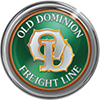Master NMFC Classes with Carrier Partnership
We never want to let our customers down or have them end up with surprises on their freight bill. Our entire business is founded on service and trust.
For more than 80 years, the National Motor Freight Classification (NMFC) standard has determined the freight classes of commodities for motor carriers. The NMFC system standardizes thousands of commodities that go through LTL networks by establishing class types based on four characteristics — density, handling, stowability, and liability.
This system is important in ensuring more predictable billing for shippers and streamlining load planning for carriers, so everyone knows what to expect from the shipping process.
However, in practice, it can be complex and take shippers time to learn how to properly navigate it. This confusion can have negative effects on both shippers and carriers.
Freight classification mistakes and inaccurate Bills of Lading can create confusion, delays, and unexpected charges on final invoices. These unanticipated fees are reflected on the carrier’s invoice and then either absorbed by the shipper or passed on to their customers. If the carrier has to reclassify freight because it was incorrect on your BOL, it takes time, energy, and incurs clerical costs for both shipper and carrier.
Shippers that want predictability in their pricing should be working with a transportation partner that can help them navigate the system to avoid surprises.
Finding the Right Freight Class is Complex
Misclassifying freight is a common error because determining NMFC classes is challenging. Classifications can shift if the commodity changes, and the NMFC’s published commodity codes are regularly updated.
“On average, more than half of freight is misclassified,” says Erin Topper, Director of Pricing Services for Old Dominion. Topper worked at NMFTA for 18 years and led the Freight Classification Development Council (FCDC), before joining OD in 2023.
“Since the NMFC classification must account for any commodity a company might tender to a carrier at any time, it used to have individualized items for a particular commodity or set of commodities. Over the last year and a half, the classification has been simplified and numerous items consolidated, but even those changes may be hard for individual shippers to track.”
Recently, the NMFTA announced that in spring 2025, they will start a comprehensive overhaul of the NMFC system. These changes aim to make the class system easier to use and understand by transitioning most items to a standardized density scale.
“At one point in time, the NMFC book itself was probably 900 to 1,000 pages. It was very difficult for shippers to really dig into the NMFC and figure out exactly what the classification of their product was,” Topper says. “There’s been a change in philosophy. And that change goes to more being density based.”
Most shippers would prefer to focus on their day-to-day business operations rather than keeping up with the NMFC changes. That's why shippers need to partner with a carrier that will help ensure their freight classification is correct and help them avoid pricing adjustments on their final bills.
Customer Spotlight: Navigating the NMFC System with Old Dominion
Old Dominion recently worked with a customer who ships industrial air filters to resolve a freight classification issue. The customer had previously shipped their products under the NMFC air filter machine class. Then, they noticed that their class had suddenly changed to a designation for cabinets.
This increased their freight bill by hundreds of dollars. This customer contacted their OD Solutions Specialist, who worked with OD’s Weight and Inspections team to request a ruling from the NMFTA to understand the classification change.
Within days, the OD team explained to the customer that the class change happened because of the way the product was shipped. The air filter product included two parts, a cabinet and an air filter. The shipper started getting increased costs because the cabinet and air filter were being shipped separately. So, the rate changed simply because the product didn't have the filter attached.
Based on their work with the NMFTA, OD was able to come back to the customer with the correct NMFC item number, an explanation in the change, and a solution that could help the customer reduce their shipping costs moving forward.
Our team is ready to answer any questions you may have about the NMFC or your freight classification. Please contact your Solutions Specialist or Customer Service at 800-235-5569.
OD Offers Personalized Assistance with NMFC Classes
We have found that the most effective approach to navigating the NMFC system is by providing one-on-one consultation to ensure our customers know how their shipment is classified and how to properly complete a BOL.
“We never want to let our customers down or have them end up with surprises on their freight bill,” says Todd Polen, Vice President of Pricing Services at Old Dominion. “Our entire business is founded on service and trust.”
“Our customers want to know their freight is protected and they can rely on their shipping costs to be predictable. People want their invoices to match the rates they were quoted. That’s why we dedicate many people within the company to understanding the NMFC and helping our customers classify their freight correctly up front,” Polen said.
As an OD customer, you will have a local Solutions Specialist to assist with all of your account needs.
Key areas of support include:
Identifying the correct NMFC code and freight class for your shipment(s)
Notifying you of industry changes and updates that could affect your business
Providing an accurate freight estimate to avoid invoice discrepancies
Consulting on OD’s array of shipping services to help you choose the best solution
Troubleshooting any potential issues and future problem resolution
What matters most is that shippers know how their freight is classified, they are given an accurate estimate, and there are no surprises on their final bill. When in doubt, get in touch with your carrier and let them know about any changes to the weight, packaging, or commodity of your freight. No matter what you want to ship, OD is here to make it predictable while helping you deliver your customer's promises.
Unpacking NMFC Classifications
Understanding freight class is a critical part of the shipping process. If freight is not properly classified, the most accurate rates may not be applied, and this can lead to an unwelcome surprise on the final bill.
In this episode, hear from Old Dominion’s Director of Pricing Services, Erin Topper. Erin previously spent 18 years at the NMFTA, where she was responsible for managing the classification development process.


